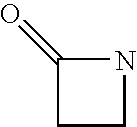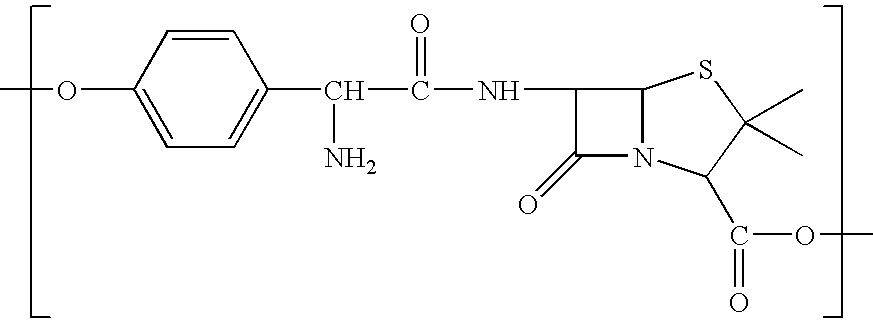Antibiotic polymers
a technology of polymers and polymers, applied in the field of antibiotic polymers, can solve the problems of patient non-compliance with finishing the course of therapy and the risk of missed doses, and achieve the effects of reducing or eliminating the risk of a patient, reducing the frequency of polymers, and facilitating local administration
- Summary
- Abstract
- Description
- Claims
- Application Information
AI Technical Summary
Benefits of technology
Problems solved by technology
Method used
Image
Examples
example 1
[0209]As illustrated below, 6-Aminopenicillanic (1 g, 2 eqv.) was treated with pyridine (25 ml) and sebacoyl chloride (0.5 mL, 1 eqv) and allowed to react for 24 hours to provide the diacid 1 below. Diacid 1 was treated with acetic anhydride at room temperature for one hour to provide the (bis)anhydride 2, which was polymerized under melt conditions at 160 degrees and 2 mm Hg for 4 hours to provide the anhydride polymer 3.
[0210]
example 2
[0211]As illustrated below, clavulinic acid (2 eqv.) can be treated with pyridine (excess) and sebacoyl chloride (1 eqv) to provide the diacid 4 below. Diacid 4 can be treated with acetic anhydride to provide the (bis)anhydride 5, which can be polymerized under melt conditions to provide the anhydride polymer 6.
[0212]
example 3
[0213]As illustrated below, the primary amine of amoxicillin (2 eqv.) can be protected (t-Boc) and the resulting material can be treated with pyridine (excess) and sebacoyl chloride (1 eqv) to provide the diacid 7 below. Diacid 7 can be treated with acetic anhydride to provide the (bis)anhydride-8, which can be polymerized under melt conditions and deprotected to provide the anhydride polymer 9
[0214]
[0215]In examples 2 and 3 the sulfur equivalent of sebacoyl chloride can be substituted to provide the corresponding thioester polymers.
PUM
| Property | Measurement | Unit |
|---|---|---|
| molar ratio | aaaaa | aaaaa |
| molar ratio | aaaaa | aaaaa |
| molecular weight | aaaaa | aaaaa |
Abstract
Description
Claims
Application Information
 Login to View More
Login to View More - R&D
- Intellectual Property
- Life Sciences
- Materials
- Tech Scout
- Unparalleled Data Quality
- Higher Quality Content
- 60% Fewer Hallucinations
Browse by: Latest US Patents, China's latest patents, Technical Efficacy Thesaurus, Application Domain, Technology Topic, Popular Technical Reports.
© 2025 PatSnap. All rights reserved.Legal|Privacy policy|Modern Slavery Act Transparency Statement|Sitemap|About US| Contact US: help@patsnap.com



